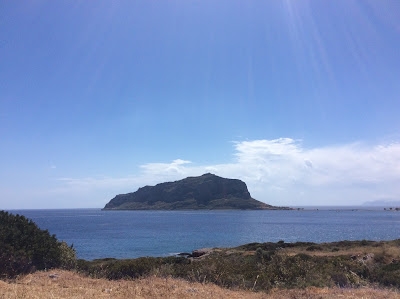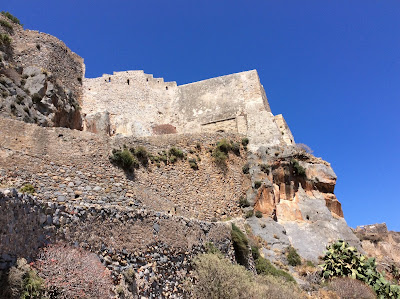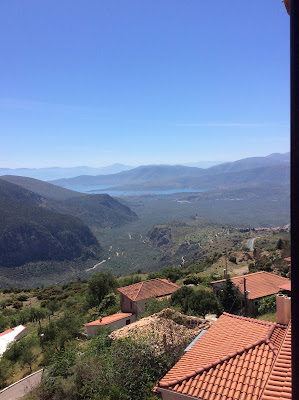A month in Greece is like a refresher course in fifth grade world history and mythology (I kept channeling Sister Joan talking about Athena, Zeus et. al., of course in a PG-13 fashion, no mention of Leda and the swan for example). It was a great trip, but comes in third to Italy and Spain in our hearts.
We started in Thessaloniki, in the north, which is the second largest city in Greece. The old town is charming and has several well known sights and museums along with a deep water port.
 |
| modern art and selfies by the port |
 |
there is a charming shopping area packed
with restaurants in the old town |
 |
| old covered market |
 |
| remains of city wall around the kastro (castle) |
 |
| city view from the kastro |
 |
| local residents in the kastro area |
 |
new friends who invited us to their home when they found us
lost and searching for a church, which turned out to be next
door to their house. They introduced us to tsiporou |
 |
medieval fresco of jesus without a beard--he is believed to be
around 15 years old in the fresco according to local experts |
 |
| fresco in San Demetreo (7th century) |
 |
| roman ruins in Thessaloniki town center |
After a few days in Thessaloniki we headed for Meteora, a UNESCO world heritage site with 7 medieval monasteries built on pillars of rock to afford protection from marauders and infidels. We got off to a bit of a bumpy start when we checked out and asked them to call us a cab to the station--turns out there was a national taxi strike! There was a bus to the train station but we were worried we hadn't left enough time to make it since we were planning to be lazy and cab it. Fortunately, much as in Italy, the train was 25 minutes late, so we made it with ease. Other than the tardiness, the train system was quite efficient and our assigned seats were very comfortable. The air conditioning even worked! We are not used to such luxuries on the local Italian trains.
When Meteora was built, the only access was by scaling the cliffs. Staircases were added in the early 1900s, and you can now reach several of them by road. We took a Meteora by evening tour in a mini van and saw all of the monasteries and a museum. Much better than renting a car and driving the twisting roads ourselves, I don't think our GPS would have been much use trying to find the monasteries.
 |
picture taking frenzy at sunset
|
We had planned to take public transport to our next stop, Delphi, but found that it would be over 8 hours due to problems with the trains, so we splurged and had a driver take us in minivan splendor, less than 3 hours to get to our doorstep. He was very friendly and showed us sights along the way, including the battlefield at Thermopylae, marked with statues and a museum.
 |
Statue of Leonidas at the site of the 430 BC battle at Thermopylae. Leonidas led
a band of 300 Spartans who, with other allies, held off the Persian invaders led by Xerxes I
for 3 days before falling in defeat, a battle said to have changed the course of Greek history. |
Delphi is a sleepy little town but one of the most visited spots in Greece, currently by tourists, but from 600 BC onward by pilgrims seeking guidance from the oracle. Luckily we were there a little before tourist season got into full swing, and we also got up early and made it to the site shortly after it opened, before the onslaught of tourist buses from Athens and Thessaloniki. It is a steep climb up the sacred way (the same route taken 2500 years ago) to reach the spot where the ancient oracle gave her pronouncements, then the route continues uphill to the temple of Athena and the theater, and even further up to the stadium.
 |
Tom is standing next to a replica of the stone believed to have been
thrown from the heavens by Zeus to mark the center of the universe. |
 |
View from above the theater (above) and
from our hotel window (below)
|
Finally we made it by bus to Athens, a large and crowded city and home to 1 out of 3 Greeks. Athens has made great strides in reducing pollution, but we still saw a haze on the horizon, which our cab driver claimed was smog blown over from Africa--seems doubtful given the direction of the prevailing wind. We had a view of the acropolis from the rooftop terrace at our hotel, and of course visited it on our first day there. The Parthenon is still being renovated, a massive project expected to take 50 years in total, longer than it took to build it originally.
 |
Acropolis at night, view from hotel room
|
 |
| Stadium built for first modern Olympics in 1896 |
 |
| View from highest hill in Athens |
 |
| bronze statue at National Archaeological museum |
We visited the national archaeological museum which contains most of the ancient treasures of Greece that are not in London or New York. There is an electronic sign in the entry asking visitors to vote on whether the Elgin marbles should be returned to Greece. Not surprisingly, almost every voter said yes. We also visited the Benaki museum which contains additional treasures, watched the changing of the guard at the tomb of the unknown soldier, visited the Temple of Zeus, ascended the highest hill in Athens, stumbled upon street markets, learned that Attaturk (the father of modern Turkey) was born in Greece and his former home is now an embassy) and visited many Greek Orthodox churches, which are all built on the same plan by church law according to an italian tour guide we eavesdropped on at one church.
 |
mask of agamemnon, pure gold (left)
traditional greek clothing (above) |
 |
changing of the guard at the tomb of the unknown soldier. the soldiers
are wearing traditional uniforms, including kilts with 400 pleats--one for each
year of Ottoman oppression
When it was time to leave Athens we picked up a car at the airport (I highly recommend this despite the cost of the cab--driving in Athens would be difficult) and headed to the Peloponese and the Mani Penninsula for a week. We started in tiny Kardamylli which is a beautiful small town and which was a great base for a full day driving tour of the penninsula. Beaches, mountain and sea views, and flowers everywhere made for a beautiful drive.
|


 |
| entry to Kardamylli Old Town |
 |
| local heroes (left and above) |
 |
| only traffic we saw all day |
 |
Small roadside 'churches' are along every
roadside in memory of a loved one or in thanks
for having survived an accident. |
After a night at Monemvasia we headed to Ermione, where we parked the car and took the ferry to Hydra, an island where no cars are allowed and donkeys are lined up at the dock to transport everything from luggage to refrigerators up the hills.
 |
| in front of Hydra harbor |
 |
| fresh fish for lunch |
 |
| Hydra harbor |
 |
| waiting to transport luggage |
Hydra is beautiful and peaceful despite the many tourists. It is easy to see why it is a favorite week-end destination for Athenians, many of whom own vacation homes on the island. It was only a 20 minute ride on the "flying dolphin" back to Ermione where we reclaimed the car and headed to Napflion via Ephadavrous, an archaeological site famed for having the best ancient theater in Greece. The acoustics are so good that a person seated in the top row can hear someone whispering in the center of the arena floor. The acoustics are helped by an underground chamber beneath the center of the floor which acts as a mike and amplifies the sound. It is really surprising to stand there and hear yourself as if you were using a sound system. People really get into it. A Swiss girl sang a selection from an opera and two German girls sang what sounded like an old campfire song. My favorite was a Greek gentleman who liked it so much he did 10 minutes of 'flamenco,' stamping his feet and clapping with great enthusiasm. A group of Italian millenials said "Brescia e il capo del mundo" (Brescia is the capital of the world) and were surprised when we contradicted them and said Seattle e il capo del mundo!
 |
| Zorba at Ephadavrous |
 |
| fresh OJ only 2 euros |
Last stop in the Peloponnese, Nafplio, the first capitol of the modern Greek republic. After only a few years, the first governor was murdered and the 'powers' (England, France, Germany) insisted that the Greeks have a monarchy. King Otto from Bavaria assumed the throne in 1832 and moved the capitol to Athens. The city was named after the local hero of the Trojan war claimed (at least in Nafplio) to have invented weights and measures, lighthouses, and the first Greek alphabet. The town was destroyed in the second Messenian war in 688 BC but became an important commercial and strategic center in the Byzantine empire, around 600 AD. Now it is considered one of the most beautiful towns in Greece and hosts thousands of tourists every summer. A short drive away are the ruins of Mycenae, an ancient civilization predating the Greeks (ca. 1600-1100 BC). The acropolis dates from about 1300 BC when Mycenae was at the height of its power.

 |
lots of pedestrian shopping streets in Napflio
Above, Tom holds some worry beads in front
of the worry bead shop |
 |
| Views of Napflio from the fortress (above and below) |
 |
Climb up to Palamidas a large fortress
overlooking the city(left), dancers
preparing for a performance at the castle (above) and
musicians (below)
|
 |
Above: At the Lion Gate entry to the acropolis at Mycenae. The lintel above our
heads weighs 120 tons, 4x the size of the stones used to build the pyramids
Below: part of the Mycenaean ruins on the acropolis
|
Returning to Athens, we dropped off the car and hopped a cheap flight to Chaina on Crete for our last 5 days in Greece. Chaina (or Xaina) is another beautiful
port town and a great place to enjoy the beautiful weather and fresh seafood. In addition, the famous ruins at Knossos and the related archaeological museum are only a two hour drive away.
 |
Tom in front of Venetian port (left)
local hero (above) |
 |
world's smallest merry go round?
|
Tom ordered a medium beer and got this boot o'beer! What could he do but drink it? If some of you got indecipherable postcards it is because he wrote them while drinking his liter of beer.
 |
| pastitsio (baked pasta/beef/bechamal) |
 |
Our waiter insisted we have some "holy
water:" raki with a cross in the bottle. That
stuff is potent. |
 |
| painting of the bull at the Palace at Knossos |
 |
The grand staircase at Knossos and the queen's
bedroom with replica of a mural now in the museum
From Crete we headed back to Arezzo, but we will hopefully return to Greece soon
to do some island hopping. Next stop, Copenhagen and Norway with Kelly, then back to Seattle.
Ciao a tutti
|



















































































